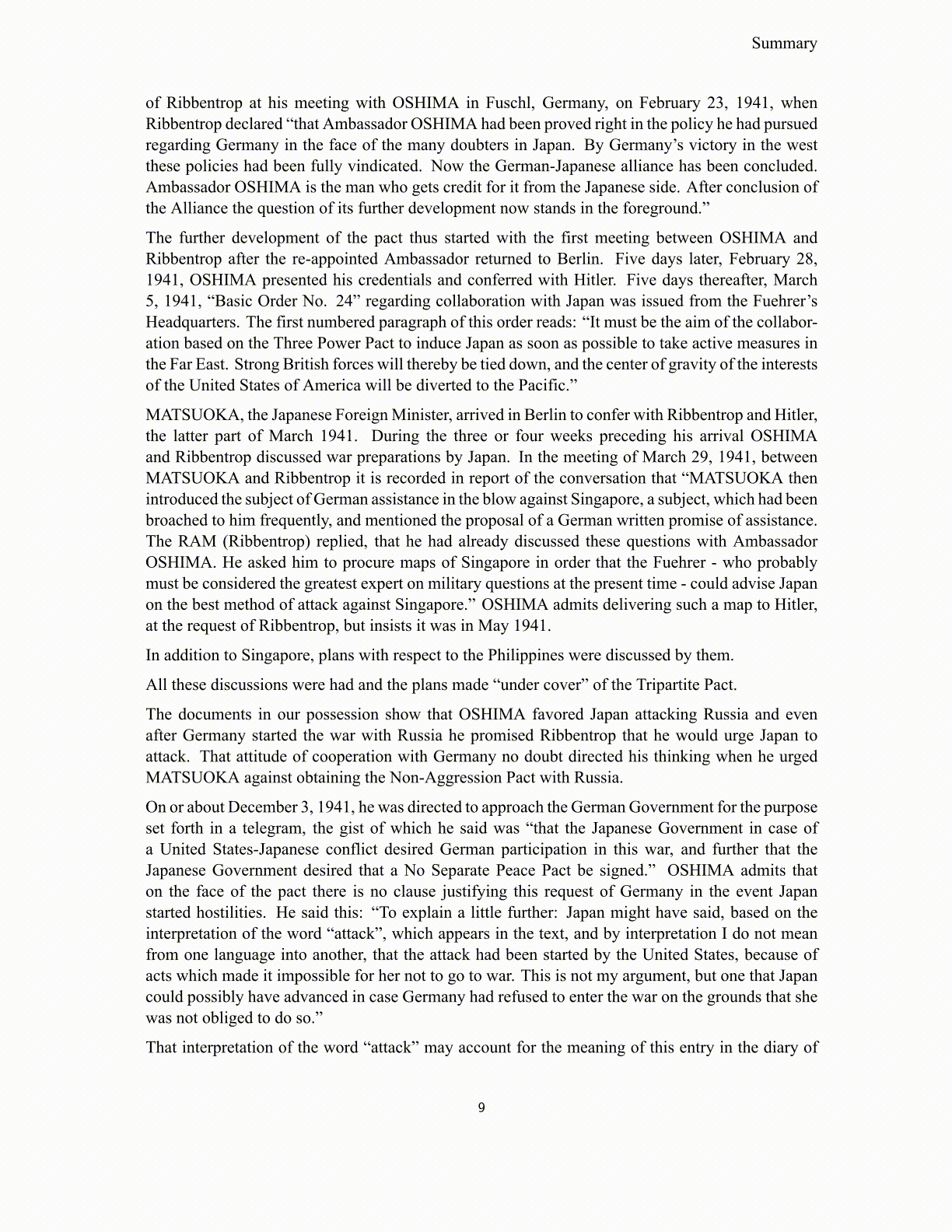
Summary of Ribbentrop at his meeting with OSHIMA in Fuschl, Germany, on February 23, 1941, when Ribbentrop declared “that Ambassador OSHIMA had been proved right in the policy he had pursued regarding Germany in the face of the many doubters in Japan. By Germany’s victory in the west these policies had been fully vindicated. Now the German-Japanese alliance has been concluded. Ambassador OSHIMA is the man who gets credit for it from the Japanese side. After conclusion of the Alliance the question of its further development now stands in the foreground.” The further development of the pact thus started with the first meeting between OSHIMA and Ribbentrop after the re-appointed Ambassador returned to Berlin. Five days later, February 28, 1941, OSHIMA presented his credentials and conferred with Hitler. Five days thereafter, March 5, 1941, “Basic Order No. 24” regarding collaboration with Japan was issued from the Fuehrer’s Headquarters. The first numbered paragraph of this order reads: “It must be the aim of the collabor- ation based on the Three Power Pact to induce Japan as soon as possible to take active measures in the Far East. Strong British forces will thereby be tied down, and the center of gravity of the interests of the United States of America will be diverted to the Pacific.” MATSUOKA, the Japanese Foreign Minister, arrived in Berlin to confer with Ribbentrop and Hitler, the latter part of March 1941. During the three or four weeks preceding his arrival OSHIMA and Ribbentrop discussed war preparations by Japan. In the meeting of March 29, 1941, between MATSUOKA and Ribbentrop it is recorded in report of the conversation that “MATSUOKA then introduced the subject of German assistance in the blow against Singapore, a subject, which had been broached to him frequently, and mentioned the proposal of a German written promise of assistance. The RAM (Ribbentrop) replied, that he had already discussed these questions with Ambassador OSHIMA. He asked him to procure maps of Singapore in order that the Fuehrer - who probably must be considered the greatest expert on military questions at the present time - could advise Japan on the best method of attack against Singapore.” OSHIMA admits delivering such a map to Hitler, at the request of Ribbentrop, but insists it was in May 1941. In addition to Singapore, plans with respect to the Philippines were discussed by them. All these discussions were had and the plans made “under cover” of the Tripartite Pact. The documents in our possession show that OSHIMA favored Japan attacking Russia and even after Germany started the war with Russia he promised Ribbentrop that he would urge Japan to attack. That attitude of cooperation with Germany no doubt directed his thinking when he urged MATSUOKA against obtaining the Non-Aggression Pact with Russia. On or about December 3, 1941, he was directed to approach the German Government for the purpose set forth in a telegram, the gist of which he said was “that the Japanese Government in case of a United States-Japanese conflict desired German participation in this war, and further that the Japanese Government desired that a No Separate Peace Pact be signed.” OSHIMA admits that on the face of the pact there is no clause justifying this request of Germany in the event Japan started hostilities. He said this: “To explain a little further: Japan might have said, based on the interpretation of the word “attack”, which appears in the text, and by interpretation I do not mean from one language into another, that the attack had been started by the United States, because of acts which made it impossible for her not to go to war. This is not my argument, but one that Japan could possibly have advanced in case Germany had refused to enter the war on the grounds that she was not obliged to do so.” That interpretation of the word “attack” may account for the meaning of this entry in the diary of 9